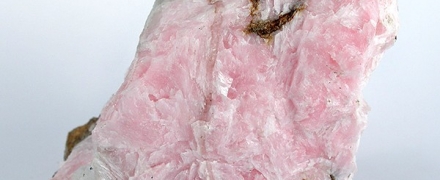open 10 am - 7 pm
laboratory is closed
Bustamit

The mineral, named after the Mexican president, general, physician and naturalist Anastasio Bustamente y Oseguera (1780-1853), had a difficult fate. Initially discovered and described by Alexander Brongniart (Alexandre Brongniart, 1770-1847), the mineral turned out to be a mineral mixture, and its name was discredited. Subsequently, this name was once again assigned to a new mineral, which has a similar chemical composition with the mineral originally described by Brongnard. The author of the revival of the name was the American mineralogist Esper Larsen (Esper Signius Larsen, 1879-1961). Bustamite belongs to the pyroxenoids, namely, to the minerals of the wollastonite group. Most often it is found in rhodonite rocks, entering as a mineral in the composition of ornamental and jewelry ornamental rhodonite. Less often, this mineral is found in the form of opaque and translucent decorative collection samples, and even more rarely, bustamite is found in the form of transparent and partially transparent crystals suitable for facet cutting. The color of jewelry bustamite is characterized by brown hues with yellow, orange and pink being the main colors. Such material comes predominantly from Australian rhodonite deposits and rarely from South African deposits.
В геммологической практике бывают весьма увлекательные случаи с диагностикой ювелирных вставок
Но помимо редкости цвета и высокой стоимости таких камней, многие розовые камни выделяются одной замечательной особенностью – они проявляют плеохроизм, то есть в зависимости от положения осмотра камня он может иметь дополнительные оттенки – оранжевый или пурпурный.
Currently, gemstones are produced by two fundamentally different technological methods - the High Pressure - High Temperature method (“HPHT”, High-pressure & High-temperature) and the Chemical Vapor Deposition (“CVD”, Chemical vapor deposition) method. The "HPHT" method is the most tested classical synthesis method, which can be used both carbon deposition on diamond from flux melts and catalytic reactions. In "CVD" synthesis, diamond growth occurs on a seed during carbon deposition mainly from a gaseous medium at relatively low temperatures and pressures.
Jewelry and precious stones are just such a category of goods, when buying which you need to pay attention to many criteria.
Sogdianite is a rather rare mineral and more often it can be found as a collection material (moreover, in systematic collections), and it is extremely rare in jewelry.






